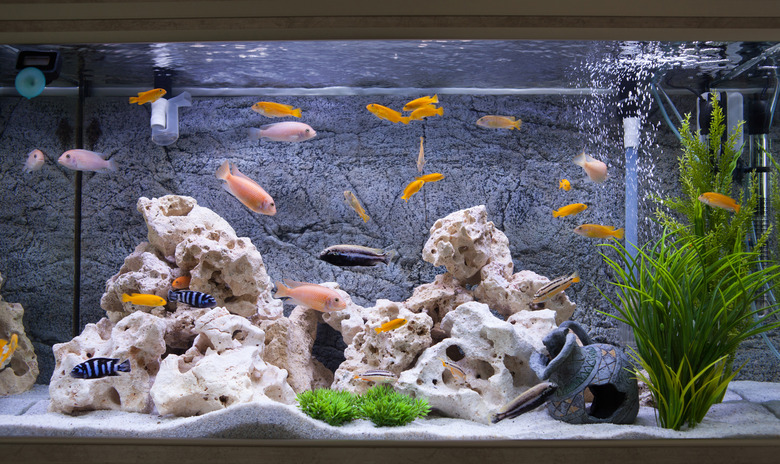How To Clean A Tank With Vinegar & Water
White vinegar provides a useful way to clean windows and other glass around your home. This common substance contains 4 to 7 percent acetic acid — the stuff that's so useful for removing water spots, lime build-up and other grunge from nonporous surfaces — according to the National Capital Poison Center. Use caution when cleaning a tank with vinegar, as improper use can harm your fish or other aquarium-kept creatures.
Clean up hard water stains
Clean up hard water stains
If you bought your tank second hand, chances are it might have a bit of dried hard water stains or algae. Hard water stains can also develop around the water line and on filters, tubes, and other equipment. The acetic acid in white vinegar is strong enough to remove the hard water deposits. Unlike many lime-removing household cleaning products, vinegar used properly won't leave a residue that can kill your fish.
Only diluted white vinegar is safe for using for cleaning a fish tank with vinegar. Other types of vinegar can contain impurities such as yeast or sulfites that don't mesh with a healthy aquarium according to Aquariawise.
Use vinegar safely
Use vinegar safely
Always remove your fish when using vinegar to clean your tank. Vinegar changes the pH of the water, causing change that can stress your fish, interfere with their body's protective slime layer, or even kill them, according to Aquariawise.
Place your fish in a container that is dedicated exclusively for use with your aquarium, such as a bucket or second aquarium. Scoop water directly from the aquarium into the container, and then gently net your fish to place them in the container.
Remove gravel, plants, filters, and tank decorations before using vinegar in your tank. The only exception is if you're using a rag dampened in vinegar to wipe hard water stains from your hood or above the water level.
Clean it up
Clean it up
Lay your tank on its side on a towel and spray the half-and-half vinegar-and-water solution directly on the glass. Let it sit for a few minutes and wipe away. You might have to use a non-scratching aquarium scrubber or aquarium scraper for especially difficult stains.
Repeat the process until the glass is clean. Rinse thoroughly, making sure that all vinegar smell is gone. Let your tank dry completely before filling it.
If you've just gotten a second-hand fish tank and don't yet have fish, use full-strength vinegar and scrub with salt to get rid of old algae and hard water stains and freshen the tank. Rinse thoroughly and be sure to cycle your tank thoroughly for a few weeks before adding any fish.
Cleaning small animal aquariums
Cleaning small animal aquariums
Cleaning a snake cage with vinegar — or one in which other small animals are kept —is different than when you have fish. Vinegar alone doesn't have the disinfectant power to kill many parasites, viruses, bacteria, and fungus that can remain in a dry aquarium and infect your pet, according to Moon Valley Reptiles.
Although vinegar is a generally non-toxic way to clean a small animal tank, residual fumes can irritate the eyes, nasal passages, and lungs, according to a safety data sheet published by SKC Inc. Make sure to rinse the vinegar off well and let the aquarium dry completely before placing your pet back in the tank.
If you're looking to sanitize your reptile or small mammal aquarium due to illness or parasites, consult your veterinarian or pet supply store for the best solutions appropriate for your particular type of pet. Never mix vinegar with any other substance such as hydrogen peroxide, as toxic gasses could sicken you as well as your animals.
